Critical Thinking for Tertiary Studies: Benefits and Strategies
VerifiedAdded on 2020/02/24
|8
|1843
|50
Essay
AI Summary
This essay examines the indispensable role of critical thinking in tertiary education. It emphasizes how critical thinking empowers students to analyze information, formulate informed conclusions, and solve complex problems. The essay highlights the benefits of critical thinking skills, such as improved problem-solving, effective communication, and adaptability in a globalized world. It also discusses the importance of fostering critical thinking competencies from early education stages, and the collaborative effort required from both students and instructors to promote these skills. Furthermore, the essay underscores the significance of tertiary study in developing well-rounded individuals and contributing to societal progress through research and innovation. The essay concludes by advocating for the integration of critical thinking across educational levels to enhance student success and prepare them for the challenges of the modern world.
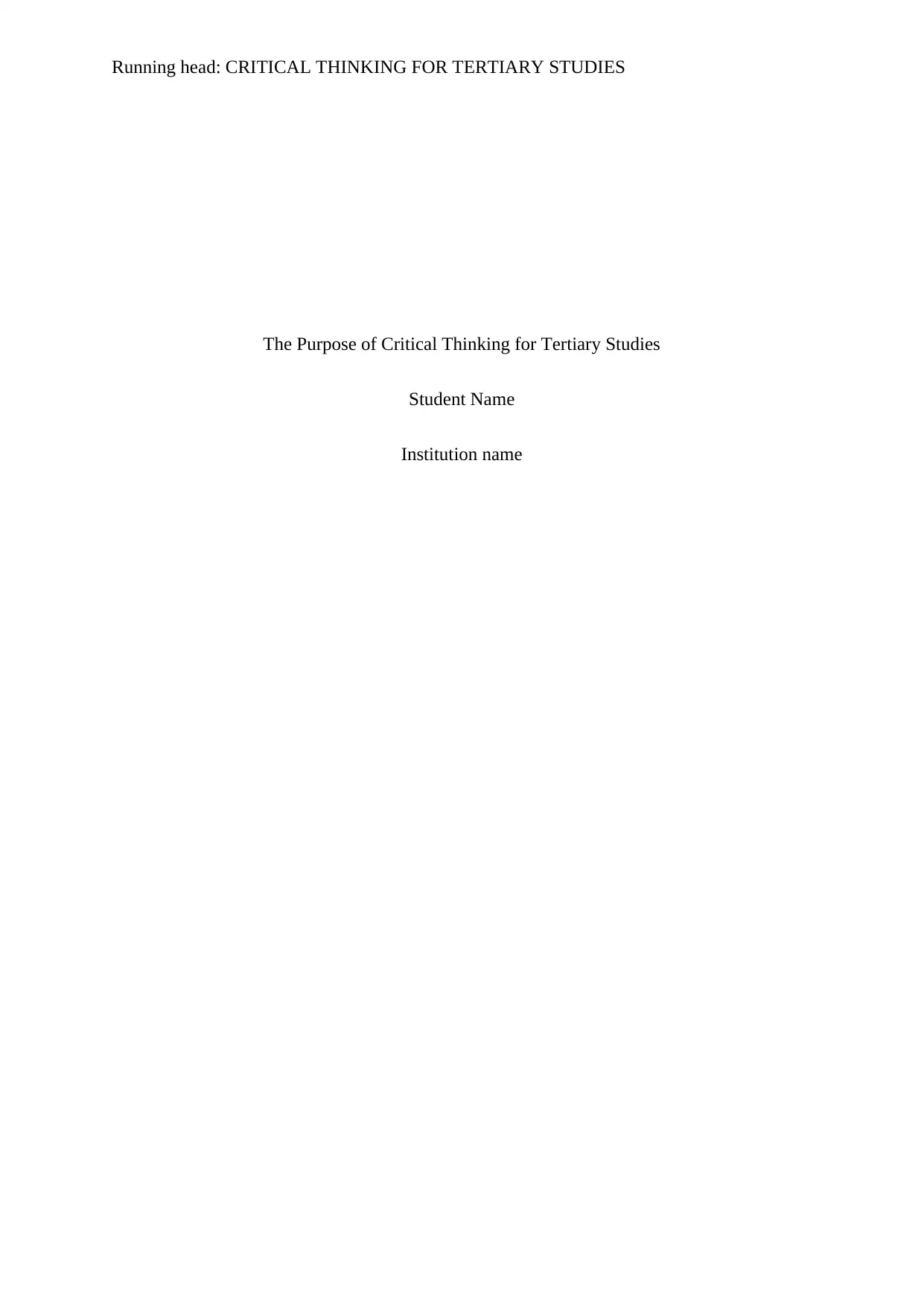
Running head: CRITICAL THINKING FOR TERTIARY STUDIES
The Purpose of Critical Thinking for Tertiary Studies
Student Name
Institution name
The Purpose of Critical Thinking for Tertiary Studies
Student Name
Institution name
Paraphrase This Document
Need a fresh take? Get an instant paraphrase of this document with our AI Paraphraser
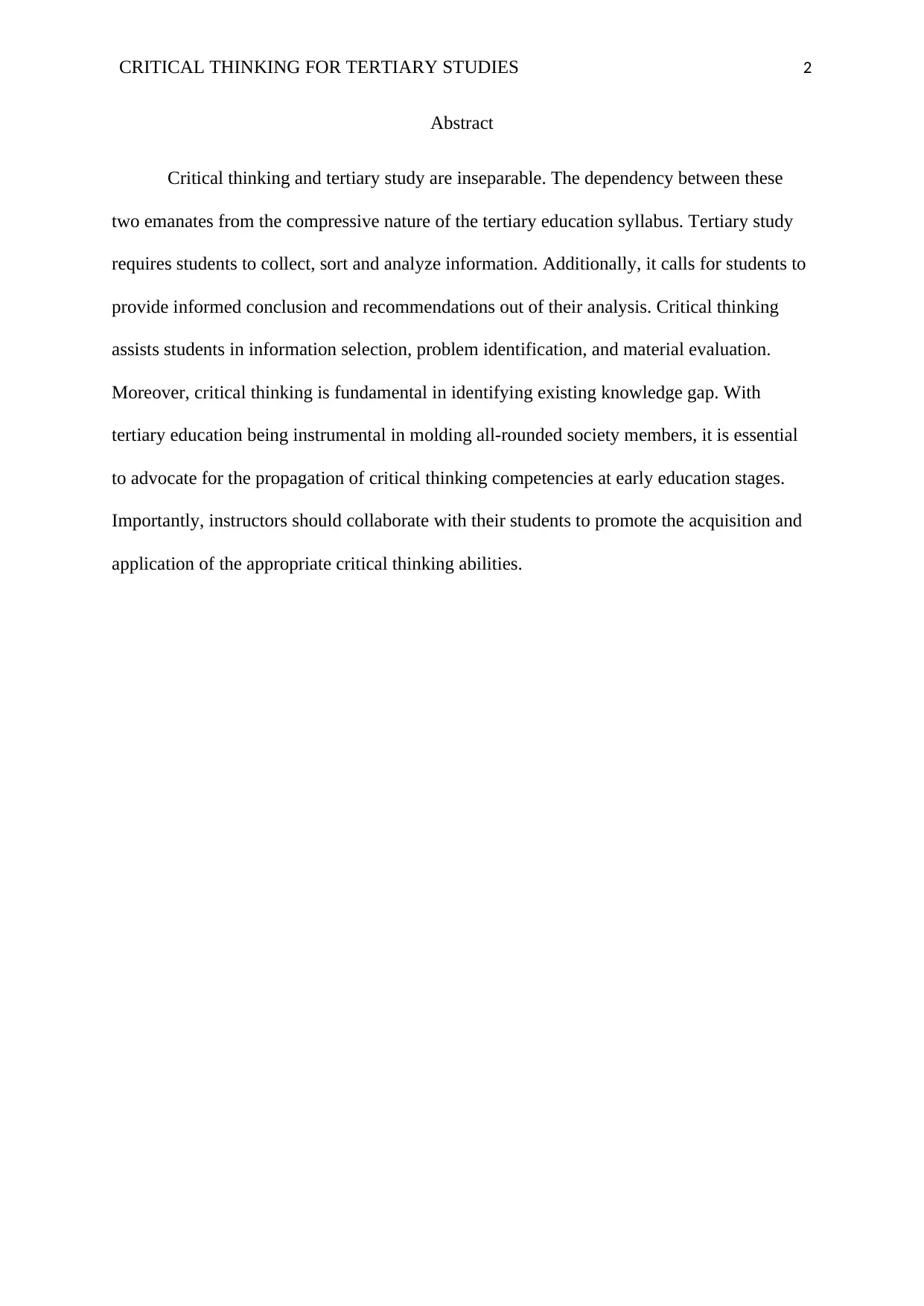
CRITICAL THINKING FOR TERTIARY STUDIES 2
Abstract
Critical thinking and tertiary study are inseparable. The dependency between these
two emanates from the compressive nature of the tertiary education syllabus. Tertiary study
requires students to collect, sort and analyze information. Additionally, it calls for students to
provide informed conclusion and recommendations out of their analysis. Critical thinking
assists students in information selection, problem identification, and material evaluation.
Moreover, critical thinking is fundamental in identifying existing knowledge gap. With
tertiary education being instrumental in molding all-rounded society members, it is essential
to advocate for the propagation of critical thinking competencies at early education stages.
Importantly, instructors should collaborate with their students to promote the acquisition and
application of the appropriate critical thinking abilities.
Abstract
Critical thinking and tertiary study are inseparable. The dependency between these
two emanates from the compressive nature of the tertiary education syllabus. Tertiary study
requires students to collect, sort and analyze information. Additionally, it calls for students to
provide informed conclusion and recommendations out of their analysis. Critical thinking
assists students in information selection, problem identification, and material evaluation.
Moreover, critical thinking is fundamental in identifying existing knowledge gap. With
tertiary education being instrumental in molding all-rounded society members, it is essential
to advocate for the propagation of critical thinking competencies at early education stages.
Importantly, instructors should collaborate with their students to promote the acquisition and
application of the appropriate critical thinking abilities.
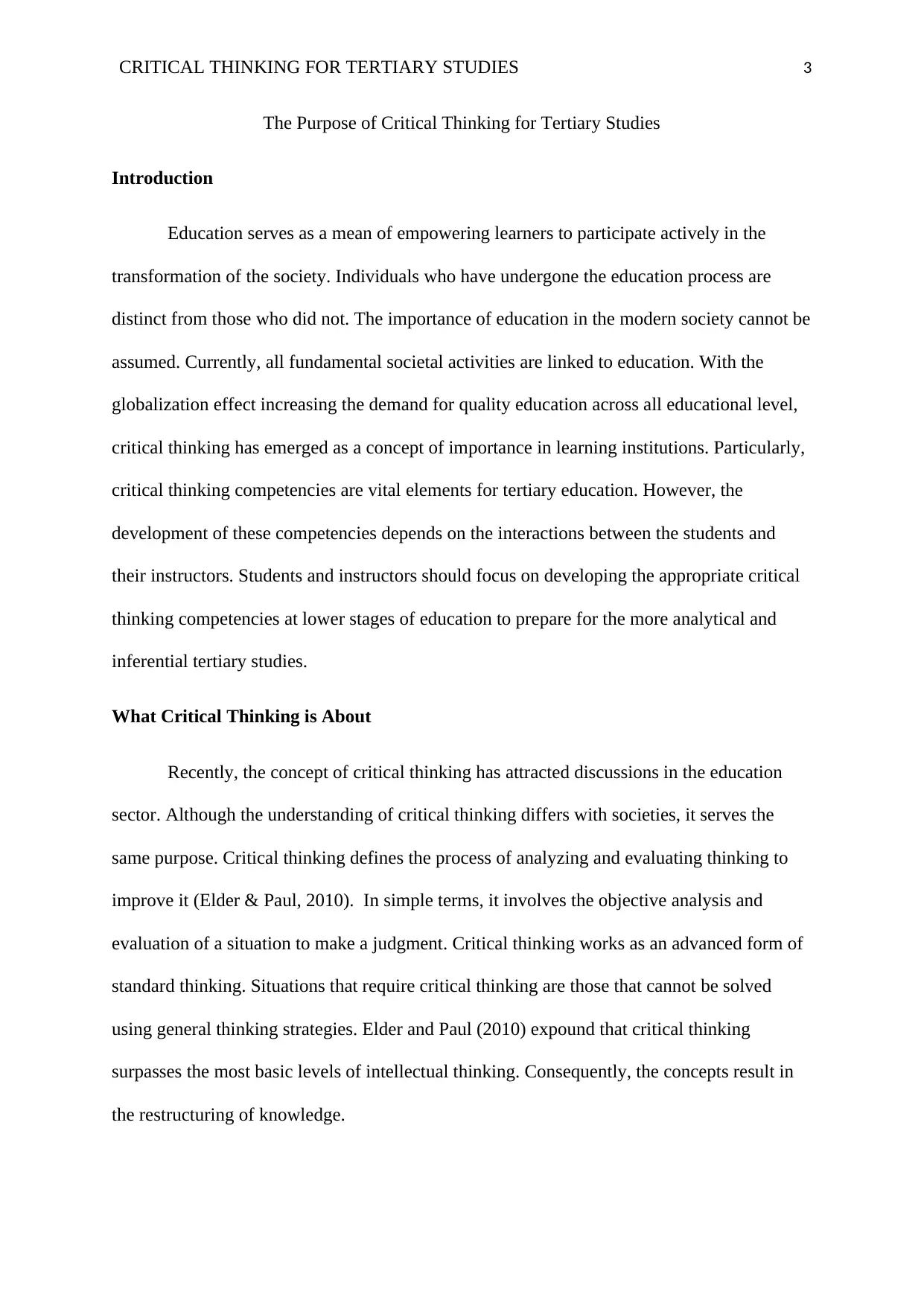
CRITICAL THINKING FOR TERTIARY STUDIES 3
The Purpose of Critical Thinking for Tertiary Studies
Introduction
Education serves as a mean of empowering learners to participate actively in the
transformation of the society. Individuals who have undergone the education process are
distinct from those who did not. The importance of education in the modern society cannot be
assumed. Currently, all fundamental societal activities are linked to education. With the
globalization effect increasing the demand for quality education across all educational level,
critical thinking has emerged as a concept of importance in learning institutions. Particularly,
critical thinking competencies are vital elements for tertiary education. However, the
development of these competencies depends on the interactions between the students and
their instructors. Students and instructors should focus on developing the appropriate critical
thinking competencies at lower stages of education to prepare for the more analytical and
inferential tertiary studies.
What Critical Thinking is About
Recently, the concept of critical thinking has attracted discussions in the education
sector. Although the understanding of critical thinking differs with societies, it serves the
same purpose. Critical thinking defines the process of analyzing and evaluating thinking to
improve it (Elder & Paul, 2010). In simple terms, it involves the objective analysis and
evaluation of a situation to make a judgment. Critical thinking works as an advanced form of
standard thinking. Situations that require critical thinking are those that cannot be solved
using general thinking strategies. Elder and Paul (2010) expound that critical thinking
surpasses the most basic levels of intellectual thinking. Consequently, the concepts result in
the restructuring of knowledge.
The Purpose of Critical Thinking for Tertiary Studies
Introduction
Education serves as a mean of empowering learners to participate actively in the
transformation of the society. Individuals who have undergone the education process are
distinct from those who did not. The importance of education in the modern society cannot be
assumed. Currently, all fundamental societal activities are linked to education. With the
globalization effect increasing the demand for quality education across all educational level,
critical thinking has emerged as a concept of importance in learning institutions. Particularly,
critical thinking competencies are vital elements for tertiary education. However, the
development of these competencies depends on the interactions between the students and
their instructors. Students and instructors should focus on developing the appropriate critical
thinking competencies at lower stages of education to prepare for the more analytical and
inferential tertiary studies.
What Critical Thinking is About
Recently, the concept of critical thinking has attracted discussions in the education
sector. Although the understanding of critical thinking differs with societies, it serves the
same purpose. Critical thinking defines the process of analyzing and evaluating thinking to
improve it (Elder & Paul, 2010). In simple terms, it involves the objective analysis and
evaluation of a situation to make a judgment. Critical thinking works as an advanced form of
standard thinking. Situations that require critical thinking are those that cannot be solved
using general thinking strategies. Elder and Paul (2010) expound that critical thinking
surpasses the most basic levels of intellectual thinking. Consequently, the concepts result in
the restructuring of knowledge.
⊘ This is a preview!⊘
Do you want full access?
Subscribe today to unlock all pages.

Trusted by 1+ million students worldwide
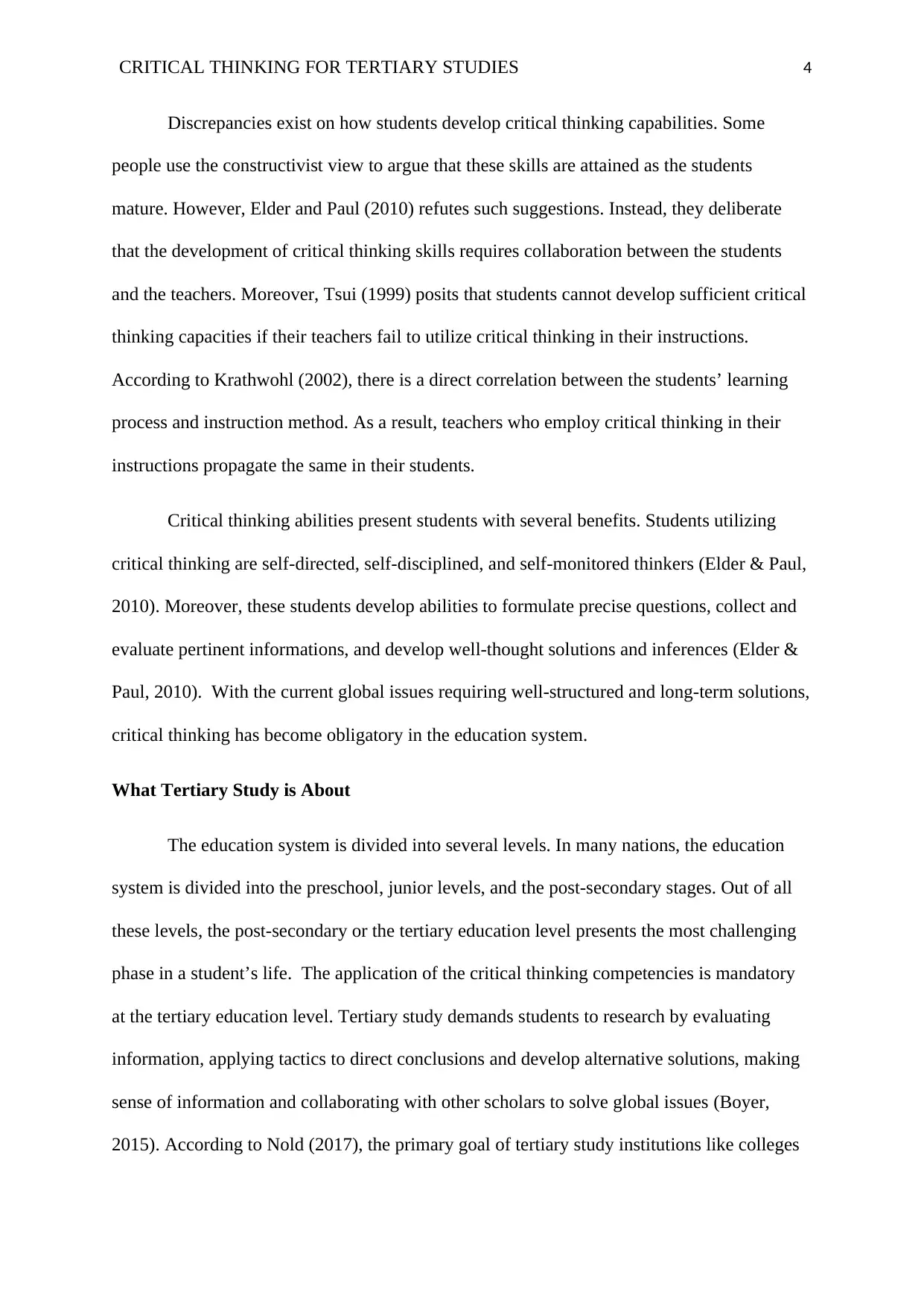
CRITICAL THINKING FOR TERTIARY STUDIES 4
Discrepancies exist on how students develop critical thinking capabilities. Some
people use the constructivist view to argue that these skills are attained as the students
mature. However, Elder and Paul (2010) refutes such suggestions. Instead, they deliberate
that the development of critical thinking skills requires collaboration between the students
and the teachers. Moreover, Tsui (1999) posits that students cannot develop sufficient critical
thinking capacities if their teachers fail to utilize critical thinking in their instructions.
According to Krathwohl (2002), there is a direct correlation between the students’ learning
process and instruction method. As a result, teachers who employ critical thinking in their
instructions propagate the same in their students.
Critical thinking abilities present students with several benefits. Students utilizing
critical thinking are self-directed, self-disciplined, and self-monitored thinkers (Elder & Paul,
2010). Moreover, these students develop abilities to formulate precise questions, collect and
evaluate pertinent informations, and develop well-thought solutions and inferences (Elder &
Paul, 2010). With the current global issues requiring well-structured and long-term solutions,
critical thinking has become obligatory in the education system.
What Tertiary Study is About
The education system is divided into several levels. In many nations, the education
system is divided into the preschool, junior levels, and the post-secondary stages. Out of all
these levels, the post-secondary or the tertiary education level presents the most challenging
phase in a student’s life. The application of the critical thinking competencies is mandatory
at the tertiary education level. Tertiary study demands students to research by evaluating
information, applying tactics to direct conclusions and develop alternative solutions, making
sense of information and collaborating with other scholars to solve global issues (Boyer,
2015). According to Nold (2017), the primary goal of tertiary study institutions like colleges
Discrepancies exist on how students develop critical thinking capabilities. Some
people use the constructivist view to argue that these skills are attained as the students
mature. However, Elder and Paul (2010) refutes such suggestions. Instead, they deliberate
that the development of critical thinking skills requires collaboration between the students
and the teachers. Moreover, Tsui (1999) posits that students cannot develop sufficient critical
thinking capacities if their teachers fail to utilize critical thinking in their instructions.
According to Krathwohl (2002), there is a direct correlation between the students’ learning
process and instruction method. As a result, teachers who employ critical thinking in their
instructions propagate the same in their students.
Critical thinking abilities present students with several benefits. Students utilizing
critical thinking are self-directed, self-disciplined, and self-monitored thinkers (Elder & Paul,
2010). Moreover, these students develop abilities to formulate precise questions, collect and
evaluate pertinent informations, and develop well-thought solutions and inferences (Elder &
Paul, 2010). With the current global issues requiring well-structured and long-term solutions,
critical thinking has become obligatory in the education system.
What Tertiary Study is About
The education system is divided into several levels. In many nations, the education
system is divided into the preschool, junior levels, and the post-secondary stages. Out of all
these levels, the post-secondary or the tertiary education level presents the most challenging
phase in a student’s life. The application of the critical thinking competencies is mandatory
at the tertiary education level. Tertiary study demands students to research by evaluating
information, applying tactics to direct conclusions and develop alternative solutions, making
sense of information and collaborating with other scholars to solve global issues (Boyer,
2015). According to Nold (2017), the primary goal of tertiary study institutions like colleges
Paraphrase This Document
Need a fresh take? Get an instant paraphrase of this document with our AI Paraphraser
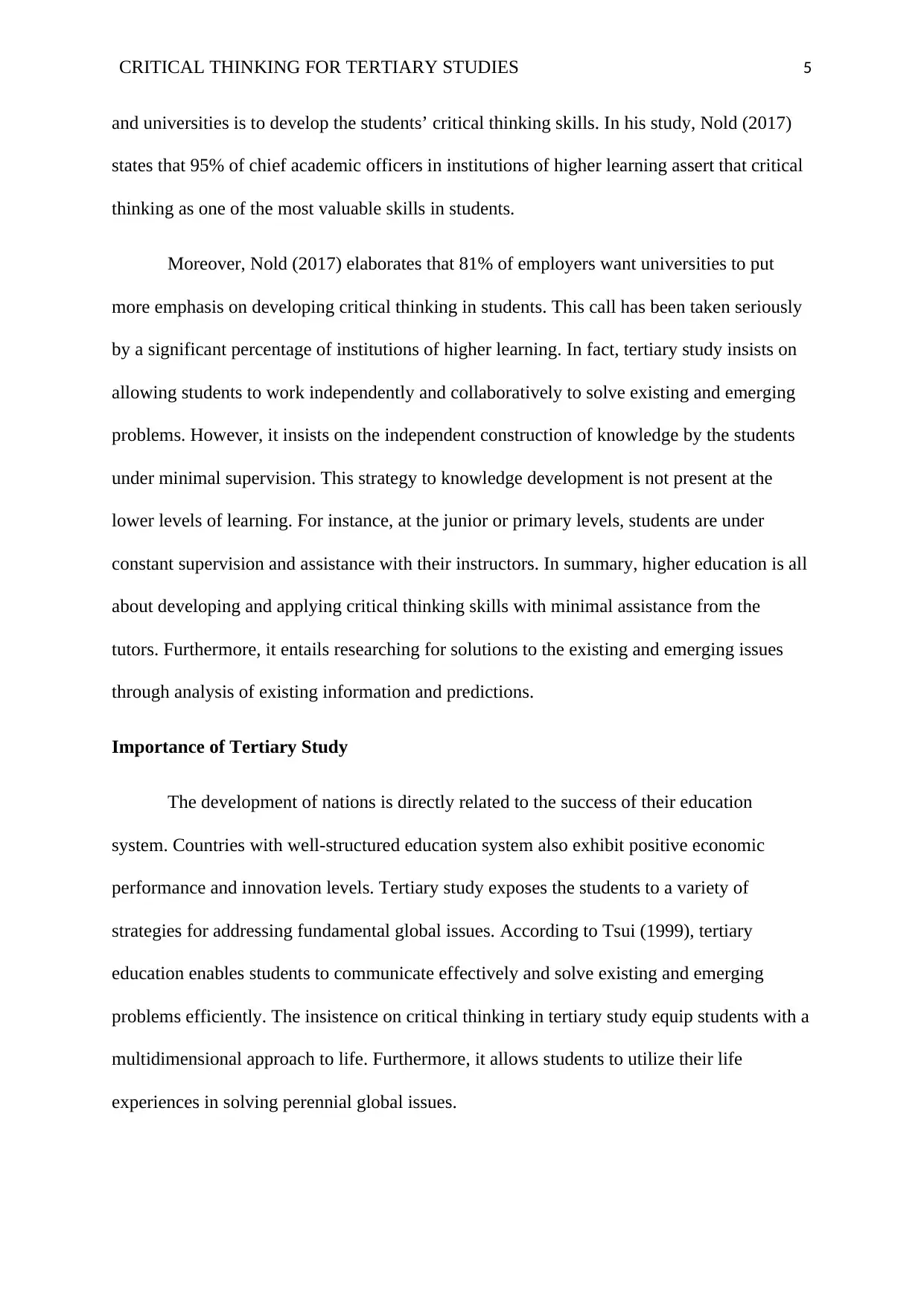
CRITICAL THINKING FOR TERTIARY STUDIES 5
and universities is to develop the students’ critical thinking skills. In his study, Nold (2017)
states that 95% of chief academic officers in institutions of higher learning assert that critical
thinking as one of the most valuable skills in students.
Moreover, Nold (2017) elaborates that 81% of employers want universities to put
more emphasis on developing critical thinking in students. This call has been taken seriously
by a significant percentage of institutions of higher learning. In fact, tertiary study insists on
allowing students to work independently and collaboratively to solve existing and emerging
problems. However, it insists on the independent construction of knowledge by the students
under minimal supervision. This strategy to knowledge development is not present at the
lower levels of learning. For instance, at the junior or primary levels, students are under
constant supervision and assistance with their instructors. In summary, higher education is all
about developing and applying critical thinking skills with minimal assistance from the
tutors. Furthermore, it entails researching for solutions to the existing and emerging issues
through analysis of existing information and predictions.
Importance of Tertiary Study
The development of nations is directly related to the success of their education
system. Countries with well-structured education system also exhibit positive economic
performance and innovation levels. Tertiary study exposes the students to a variety of
strategies for addressing fundamental global issues. According to Tsui (1999), tertiary
education enables students to communicate effectively and solve existing and emerging
problems efficiently. The insistence on critical thinking in tertiary study equip students with a
multidimensional approach to life. Furthermore, it allows students to utilize their life
experiences in solving perennial global issues.
and universities is to develop the students’ critical thinking skills. In his study, Nold (2017)
states that 95% of chief academic officers in institutions of higher learning assert that critical
thinking as one of the most valuable skills in students.
Moreover, Nold (2017) elaborates that 81% of employers want universities to put
more emphasis on developing critical thinking in students. This call has been taken seriously
by a significant percentage of institutions of higher learning. In fact, tertiary study insists on
allowing students to work independently and collaboratively to solve existing and emerging
problems. However, it insists on the independent construction of knowledge by the students
under minimal supervision. This strategy to knowledge development is not present at the
lower levels of learning. For instance, at the junior or primary levels, students are under
constant supervision and assistance with their instructors. In summary, higher education is all
about developing and applying critical thinking skills with minimal assistance from the
tutors. Furthermore, it entails researching for solutions to the existing and emerging issues
through analysis of existing information and predictions.
Importance of Tertiary Study
The development of nations is directly related to the success of their education
system. Countries with well-structured education system also exhibit positive economic
performance and innovation levels. Tertiary study exposes the students to a variety of
strategies for addressing fundamental global issues. According to Tsui (1999), tertiary
education enables students to communicate effectively and solve existing and emerging
problems efficiently. The insistence on critical thinking in tertiary study equip students with a
multidimensional approach to life. Furthermore, it allows students to utilize their life
experiences in solving perennial global issues.
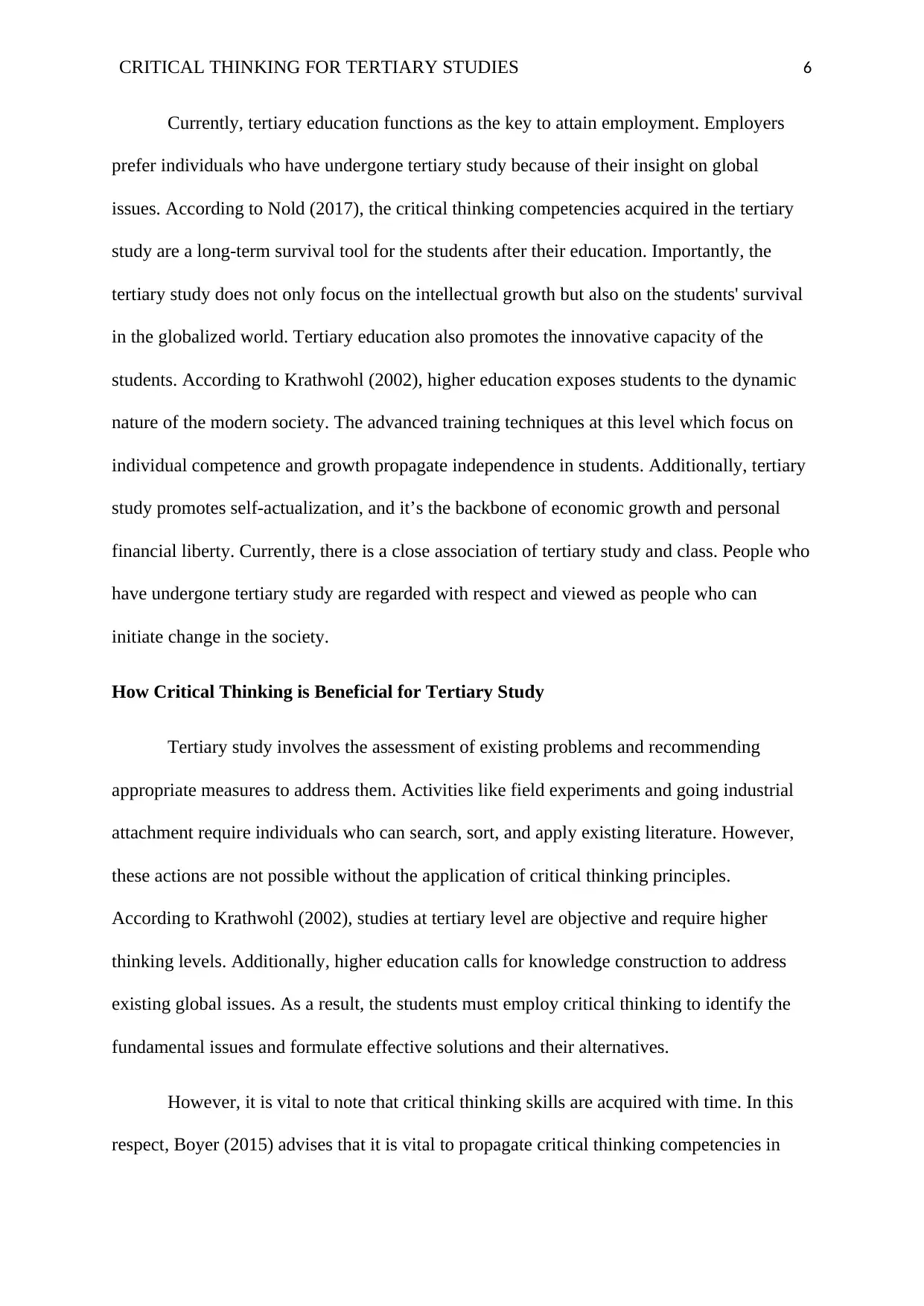
CRITICAL THINKING FOR TERTIARY STUDIES 6
Currently, tertiary education functions as the key to attain employment. Employers
prefer individuals who have undergone tertiary study because of their insight on global
issues. According to Nold (2017), the critical thinking competencies acquired in the tertiary
study are a long-term survival tool for the students after their education. Importantly, the
tertiary study does not only focus on the intellectual growth but also on the students' survival
in the globalized world. Tertiary education also promotes the innovative capacity of the
students. According to Krathwohl (2002), higher education exposes students to the dynamic
nature of the modern society. The advanced training techniques at this level which focus on
individual competence and growth propagate independence in students. Additionally, tertiary
study promotes self-actualization, and it’s the backbone of economic growth and personal
financial liberty. Currently, there is a close association of tertiary study and class. People who
have undergone tertiary study are regarded with respect and viewed as people who can
initiate change in the society.
How Critical Thinking is Beneficial for Tertiary Study
Tertiary study involves the assessment of existing problems and recommending
appropriate measures to address them. Activities like field experiments and going industrial
attachment require individuals who can search, sort, and apply existing literature. However,
these actions are not possible without the application of critical thinking principles.
According to Krathwohl (2002), studies at tertiary level are objective and require higher
thinking levels. Additionally, higher education calls for knowledge construction to address
existing global issues. As a result, the students must employ critical thinking to identify the
fundamental issues and formulate effective solutions and their alternatives.
However, it is vital to note that critical thinking skills are acquired with time. In this
respect, Boyer (2015) advises that it is vital to propagate critical thinking competencies in
Currently, tertiary education functions as the key to attain employment. Employers
prefer individuals who have undergone tertiary study because of their insight on global
issues. According to Nold (2017), the critical thinking competencies acquired in the tertiary
study are a long-term survival tool for the students after their education. Importantly, the
tertiary study does not only focus on the intellectual growth but also on the students' survival
in the globalized world. Tertiary education also promotes the innovative capacity of the
students. According to Krathwohl (2002), higher education exposes students to the dynamic
nature of the modern society. The advanced training techniques at this level which focus on
individual competence and growth propagate independence in students. Additionally, tertiary
study promotes self-actualization, and it’s the backbone of economic growth and personal
financial liberty. Currently, there is a close association of tertiary study and class. People who
have undergone tertiary study are regarded with respect and viewed as people who can
initiate change in the society.
How Critical Thinking is Beneficial for Tertiary Study
Tertiary study involves the assessment of existing problems and recommending
appropriate measures to address them. Activities like field experiments and going industrial
attachment require individuals who can search, sort, and apply existing literature. However,
these actions are not possible without the application of critical thinking principles.
According to Krathwohl (2002), studies at tertiary level are objective and require higher
thinking levels. Additionally, higher education calls for knowledge construction to address
existing global issues. As a result, the students must employ critical thinking to identify the
fundamental issues and formulate effective solutions and their alternatives.
However, it is vital to note that critical thinking skills are acquired with time. In this
respect, Boyer (2015) advises that it is vital to propagate critical thinking competencies in
⊘ This is a preview!⊘
Do you want full access?
Subscribe today to unlock all pages.

Trusted by 1+ million students worldwide
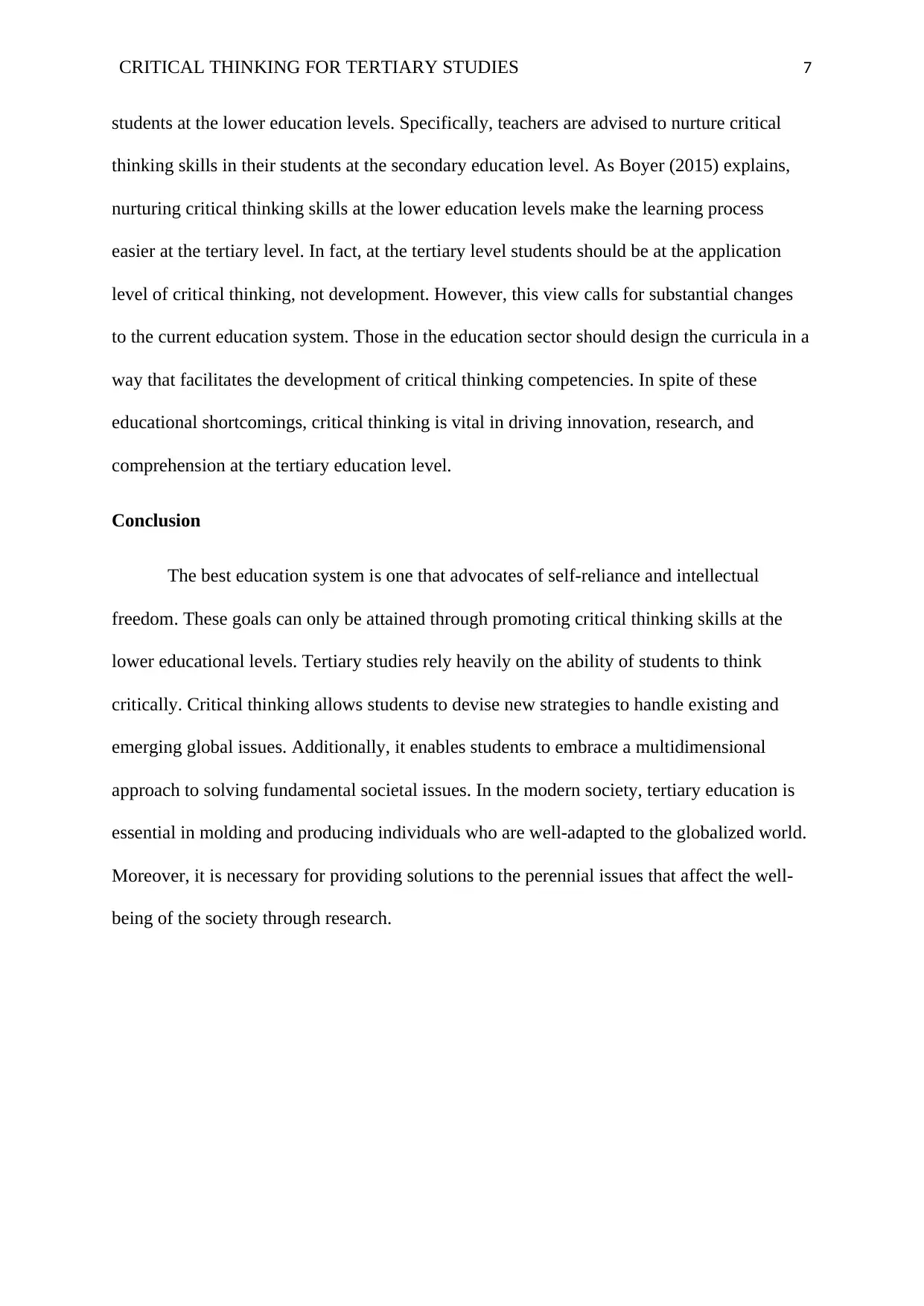
CRITICAL THINKING FOR TERTIARY STUDIES 7
students at the lower education levels. Specifically, teachers are advised to nurture critical
thinking skills in their students at the secondary education level. As Boyer (2015) explains,
nurturing critical thinking skills at the lower education levels make the learning process
easier at the tertiary level. In fact, at the tertiary level students should be at the application
level of critical thinking, not development. However, this view calls for substantial changes
to the current education system. Those in the education sector should design the curricula in a
way that facilitates the development of critical thinking competencies. In spite of these
educational shortcomings, critical thinking is vital in driving innovation, research, and
comprehension at the tertiary education level.
Conclusion
The best education system is one that advocates of self-reliance and intellectual
freedom. These goals can only be attained through promoting critical thinking skills at the
lower educational levels. Tertiary studies rely heavily on the ability of students to think
critically. Critical thinking allows students to devise new strategies to handle existing and
emerging global issues. Additionally, it enables students to embrace a multidimensional
approach to solving fundamental societal issues. In the modern society, tertiary education is
essential in molding and producing individuals who are well-adapted to the globalized world.
Moreover, it is necessary for providing solutions to the perennial issues that affect the well-
being of the society through research.
students at the lower education levels. Specifically, teachers are advised to nurture critical
thinking skills in their students at the secondary education level. As Boyer (2015) explains,
nurturing critical thinking skills at the lower education levels make the learning process
easier at the tertiary level. In fact, at the tertiary level students should be at the application
level of critical thinking, not development. However, this view calls for substantial changes
to the current education system. Those in the education sector should design the curricula in a
way that facilitates the development of critical thinking competencies. In spite of these
educational shortcomings, critical thinking is vital in driving innovation, research, and
comprehension at the tertiary education level.
Conclusion
The best education system is one that advocates of self-reliance and intellectual
freedom. These goals can only be attained through promoting critical thinking skills at the
lower educational levels. Tertiary studies rely heavily on the ability of students to think
critically. Critical thinking allows students to devise new strategies to handle existing and
emerging global issues. Additionally, it enables students to embrace a multidimensional
approach to solving fundamental societal issues. In the modern society, tertiary education is
essential in molding and producing individuals who are well-adapted to the globalized world.
Moreover, it is necessary for providing solutions to the perennial issues that affect the well-
being of the society through research.
Paraphrase This Document
Need a fresh take? Get an instant paraphrase of this document with our AI Paraphraser
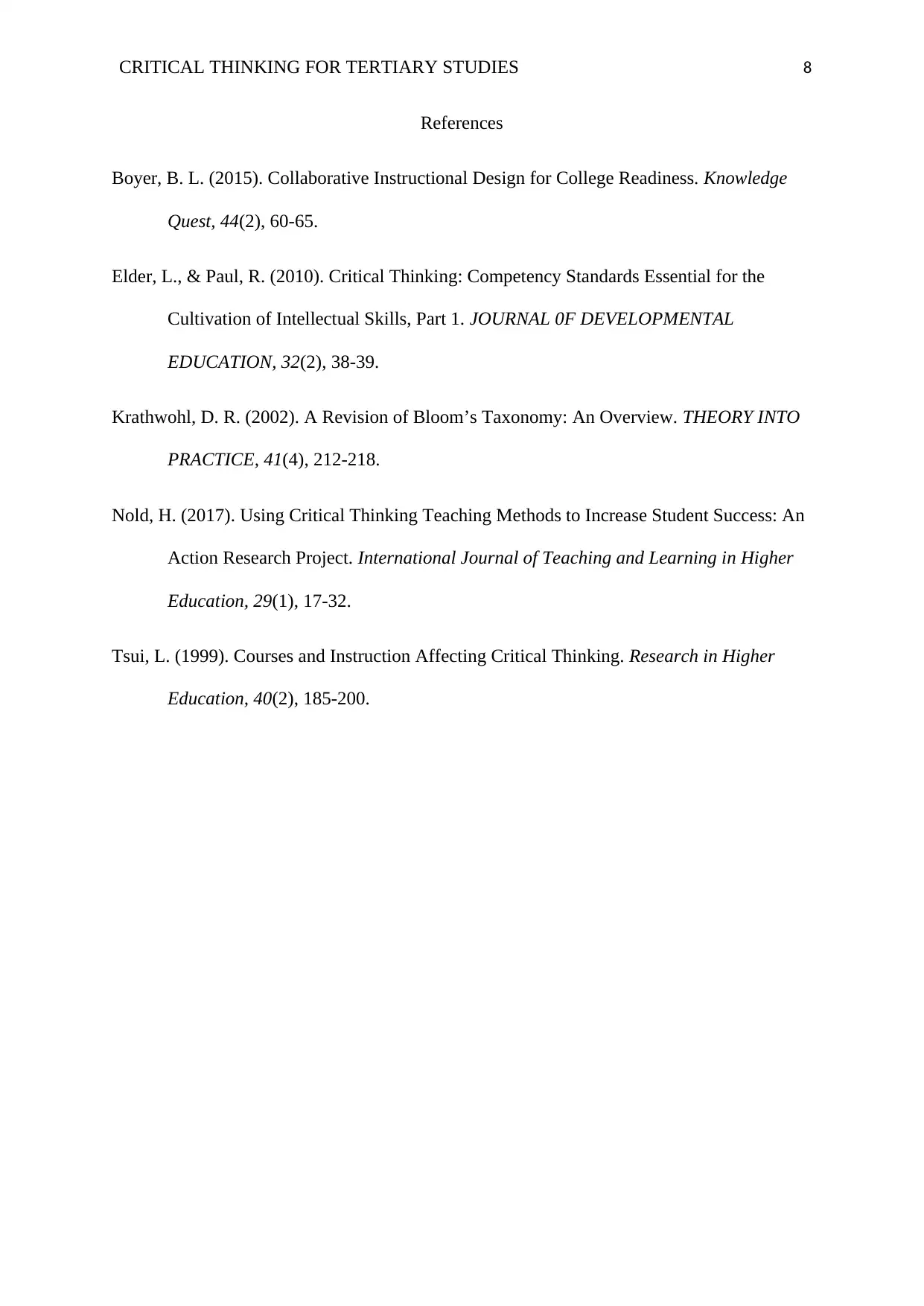
CRITICAL THINKING FOR TERTIARY STUDIES 8
References
Boyer, B. L. (2015). Collaborative Instructional Design for College Readiness. Knowledge
Quest, 44(2), 60-65.
Elder, L., & Paul, R. (2010). Critical Thinking: Competency Standards Essential for the
Cultivation of Intellectual Skills, Part 1. JOURNAL 0F DEVELOPMENTAL
EDUCATION, 32(2), 38-39.
Krathwohl, D. R. (2002). A Revision of Bloom’s Taxonomy: An Overview. THEORY INTO
PRACTICE, 41(4), 212-218.
Nold, H. (2017). Using Critical Thinking Teaching Methods to Increase Student Success: An
Action Research Project. International Journal of Teaching and Learning in Higher
Education, 29(1), 17-32.
Tsui, L. (1999). Courses and Instruction Affecting Critical Thinking. Research in Higher
Education, 40(2), 185-200.
References
Boyer, B. L. (2015). Collaborative Instructional Design for College Readiness. Knowledge
Quest, 44(2), 60-65.
Elder, L., & Paul, R. (2010). Critical Thinking: Competency Standards Essential for the
Cultivation of Intellectual Skills, Part 1. JOURNAL 0F DEVELOPMENTAL
EDUCATION, 32(2), 38-39.
Krathwohl, D. R. (2002). A Revision of Bloom’s Taxonomy: An Overview. THEORY INTO
PRACTICE, 41(4), 212-218.
Nold, H. (2017). Using Critical Thinking Teaching Methods to Increase Student Success: An
Action Research Project. International Journal of Teaching and Learning in Higher
Education, 29(1), 17-32.
Tsui, L. (1999). Courses and Instruction Affecting Critical Thinking. Research in Higher
Education, 40(2), 185-200.
1 out of 8
Related Documents
Your All-in-One AI-Powered Toolkit for Academic Success.
+13062052269
info@desklib.com
Available 24*7 on WhatsApp / Email
![[object Object]](/_next/static/media/star-bottom.7253800d.svg)
Unlock your academic potential
Copyright © 2020–2025 A2Z Services. All Rights Reserved. Developed and managed by ZUCOL.





